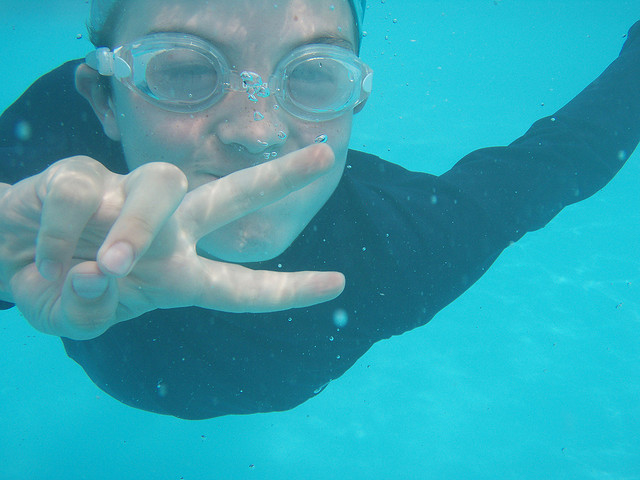
Simon Reid, The University of Queensland and Una Ryan, Murdoch University
Summer holidays are upon us, and many of us will finally get to spend some lazy days by the pool. But how can you ensure this pleasant experience doesn’t leave you with any nasty surprises?
Many infectious bugs (micro-organisms) use water to spread to new hosts. As such, swimming pools can be a major source of gastrointestinal illness.
Many waterborne outbreaks are never identified. Fewer than 10% of ill people go to their doctor and most of these don’t submit samples for laboratory testing. Even if they did, organisms are difficult to detect in water and they’re often gone by the time the investigation takes place.
What kinds of bugs live in pools and spas?
The majority of bugs that end up in swimming pools originate in our gastrointestinal tract and arrive via faecal contamination (poo) or are washed off a dirty bottom.
The tiny, single-cell parasites Cryptosporidium and Giardia are the leading causes of pool-related gastroenteritis in Australia and worldwide. These parasites can cause diarrhoea, dehydration, weight loss, abdominal pain, fever, nausea and vomiting.
Cryptosporidium or Giardia are particularly suited to waterborne transmission. This is because they’re resistant to chlorine and highly infectious. A small amount of contaminated faeces is enough to infect many fellow swimmers.
A number of viruses and bacteria – such as Shigella spp, Escherichia coli and Norovirus – also spread via swimming pools, causing gastroenteritis. Symptoms are similar to those usually associated with “food-poisoning”: vomiting, diarrhoea (sometimes bloody), fever and stomach cramps.
Some kinds of E. coli may also produce a harmful toxin. Shiga toxin can cause bloody diarrhoea and hemolytic uremic syndrome (HUS), a type of kidney failure. But this is most commonly associated with food and not swimming pools.

Watch out for smelly, dirty, cloudy and poorly maintained pools and spas. PROstatic416/Flickr, CC BY-NC
The good news is that proper pool chlorination will kill these bacterial and viral pathogens.
Naegleria fowleri, the cause of amoebic meningitis (aka the brain-eating parasite), lives in warm, unchlorinated fresh water and recently caused the tragic deaths of three children.
Naegleria fowleri enters the body with water forced up the nose. It is mostly an issue for children and others who swim in freshwater lakes, rivers and hot springs, and those who swim in warm and inadequately chlorinated swimming pools.
Is it OK to put your head under?
Yes, but try not to drink the water. The main issue is accidental (or intentional) ingestion.
Most ear infections swimmers suffer are associated with repeated and prolonged wetting of the ear canal and not with specific pathogens in the water.
What does a strong smell of chlorine mean?
The smell of chlorine sounds like it would be a good thing, but it isn’t.
The strong “chlorine” odour associated with swimming pools is due to chloramines and not chlorine. Chloramines are a by-product of the chemical reaction between chlorine and nitrogen from human sweat and urine.
The process of superchlorination, or the addition of extra chlorine, destroys ammonia and organic compounds. This reduces chloramines, eliminates the smell and improves sanitisation.
A well-managed pool with adequate levels of chlorine should, in fact, have no odour.
How common is it to find urine and faeces in pool water?
Urine is generally sterile, so apart from the yuck factor it’s not going to do you any harm. It does, however, feed the chemical process that produces chloramines and thus reduces the effectiveness of chlorination.
Faeces enters pools mostly from other swimmers' “accidents”. Recent studies show that, worldwide, most pools have at least one “accidental faecal release” every week throughout summer, and even daily in hydrotherapy pools or those highly used by non-toilet-trained infants and toddlers. Commercially available swim nappies reduce the problem, but some release will still generally occur.

Most pools are regularly contaminated with accidental faecal releases. USAG Italy/Flickr, CC BY-NC
Accidental faecal releases are treated with high doses of chlorine, which are added to the contaminated area. In some instances, pools are closed to the public, then either emptied, disinfected and refilled, or the entire pool is superchlorinated (usually requiring a 12- to 24-hour closure).
What kinds of pools are the biggest culprits?
Watch out for smelly, dirty, cloudy and poorly maintained pools. Water should generally be crystal clear and the tiles around the edges clean and grease-free.
What can you do to protect yourself?
There is a limit to how far we can rely on sanitisation and cleaning to reduce the risk of pool-associated infections. Even the best-maintained pool can contain chlorine-resistant micro-organisms.
The best solution? Don’t get bugs in the pool in the first place. Follow the simple advice plastered on the walls of every facility: shower before entering, don’t swim if you’re sick with diarrhoea and make sure children are taken for frequent toilet breaks.

Simon Reid, Associate Professor or Communicable Disease Control, The University of Queensland and Una Ryan, Professor in Biochemistry, Murdoch University
This article was originally published on The Conversation. Read the original article.



